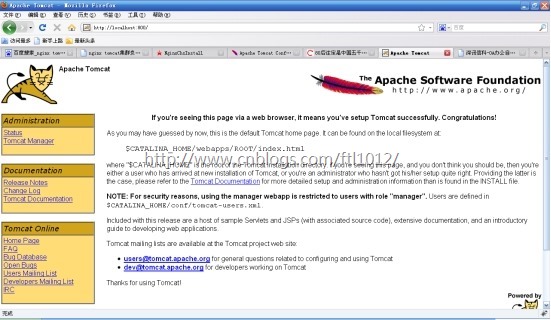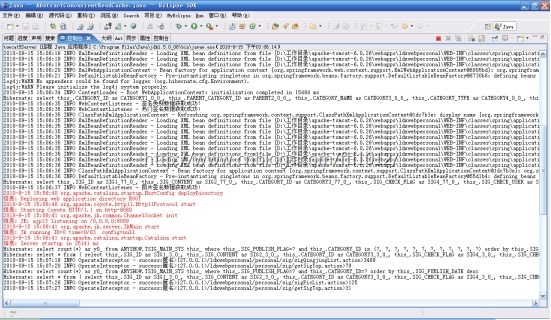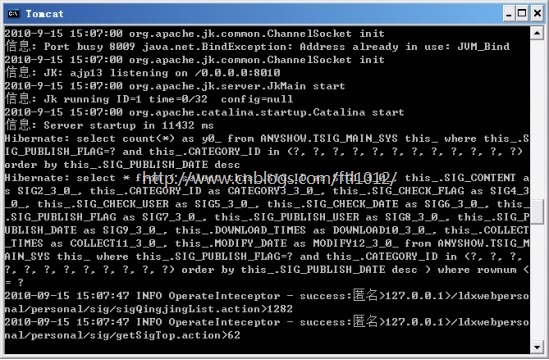Nginx+Tomcat在Windows下做负载均衡
一、 为什么需要对Tomcat服务器做负载均衡
Tomcat服务器作为一个Web服务器,其并发数在300-500之间,如果有超过500的并发数便会出现Tomcat不能响应新的请求的情况,严重影响网站的运行。另外,在访问量大的情况下,Tomcat的线程数会不断增加。由于Tomcat自身对内存的占用有控制,当对内存的占用达到最大值时便会出现内存溢出,对网站的访问严重超时等现象,这时便需要重新启动Tomcat以释放占用的内存,这样做便会阻断网站运行。
所以对Tomcat做负载均衡便很有必要。目前可以和Tomcat做负载均衡的主流服务器是Apache,但是Nginx由于功能多、配置简单等优点逐渐成为很多负载均衡服务器的首选。Nginx的并发数可达到50000,所以理论上可以和Tomcat以1:100的比例来配置,这样便可以很好的解决网站并发瓶颈问题。
二、 Nginx+Tomcat在Windows下负载均衡配置方法
Nginx+Tomcat在Windows下做负载均衡相对在Linux下简单不少,因为不论是Nginx还是Tomcat只需要下载Windows下的安装包解压到某个目录下,然后就可以做配置了。
我选择的Nginx是nginx-0.8.49这个版本,Tomcat选择的是apache-tomcat-6.0.26。
下面就是配置过程:
1.将nginx-0.8.49.rar压缩包直接解压到某个目录下(如D:/负载均衡/nginx)。
2.将apache-tomcat-6.0.26.rar压缩包解压,因为是做负载均衡,所以至少要解压两个。(如分别解压到D:/负载均衡/tomcat_1和D:/负载均衡/tomcat_2下面)。
3.将要发布的项目发布到两个Tomcat根目录下的webapps下,保证两个Tomcat下面的项目名称相同。
4.修改其中一个Tomcat的配置文件,该配置文件位于Tomcat目录下的/conf/下,文件名为server.xml,修改其中的<Server port="8005" shutdown="SHUTDOWN">为<Server port="8006" shutdown="SHUTDOWN">,修改其中的
<Connector port="8080" protocol="HTTP/1.1"
connectionTimeout="20000"
redirectPort="8443" />
为
<Connector port="8088" protocol="HTTP/1.1"
connectionTimeout="20000"
redirectPort="8443" />
修改后的文件如下:
<?xml version='1.0' encoding='utf-8'?>
<!--
Licensed to the Apache Software Foundation (ASF) under one or more
contributor license agreements. See the NOTICE file distributed with
this work for additional information regarding copyright ownership.
The ASF licenses this file to You under the Apache License, Version 2.0
(the "License"); you may not use this file except in compliance with
the License. You may obtain a copy of the License at
http://www.apache.org/licenses/LICENSE-2.0
Unless required by applicable law or agreed to in writing, software
distributed under the License is distributed on an "AS IS" BASIS,
WITHOUT WARRANTIES OR CONDITIONS OF ANY KIND, either express or implied.
See the License for the specific language governing permissions and
limitations under the License.
-->
<!-- Note: A "Server" is not itself a "Container", so you may not
define subcomponents such as "Valves" at this level.
Documentation at /docs/config/server.html
-->
<Server port="8006" shutdown="SHUTDOWN">
<!--APR library loader. Documentation at /docs/apr.html -->
<Listener className="org.apache.catalina.core.AprLifecycleListener" SSLEngine="on" />
<!--Initialize Jasper prior to webapps are loaded. Documentation at /docs/jasper-howto.html -->
<Listener className="org.apache.catalina.core.JasperListener" />
<!-- Prevent memory leaks due to use of particular java/javax APIs-->
<Listener className="org.apache.catalina.core.JreMemoryLeakPreventionListener" />
<!-- JMX Support for the Tomcat server. Documentation at /docs/non-existent.html -->
<Listener className="org.apache.catalina.mbeans.ServerLifecycleListener" />
<Listener className="org.apache.catalina.mbeans.GlobalResourcesLifecycleListener" />
<!-- Global JNDI resources
Documentation at /docs/jndi-resources-howto.html
-->
<GlobalNamingResources>
<!-- Editable user database that can also be used by
UserDatabaseRealm to authenticate users
-->
<Resource name="UserDatabase" auth="Container"
type="org.apache.catalina.UserDatabase"
description="User database that can be updated and saved"
factory="org.apache.catalina.users.MemoryUserDatabaseFactory"
pathname="conf/tomcat-users.xml" />
</GlobalNamingResources>
<!-- A "Service" is a collection of one or more "Connectors" that share
a single "Container" Note: A "Service" is not itself a "Container",
so you may not define subcomponents such as "Valves" at this level.
Documentation at /docs/config/service.html
-->
<Service name="Catalina">
<!--The connectors can use a shared executor, you can define one or more named thread pools-->
<!--
<Executor name="tomcatThreadPool" namePrefix="catalina-exec-"
maxThreads="150" minSpareThreads="4"/>
-->
<!-- A "Connector" represents an endpoint by which requests are received
and responses are returned. Documentation at :
Java HTTP Connector: /docs/config/http.html (blocking & non-blocking)
Java AJP Connector: /docs/config/ajp.html
APR (HTTP/AJP) Connector: /docs/apr.html
Define a non-SSL HTTP/1.1 Connector on port 8080
-->
<Connector port="8088" protocol="HTTP/1.1"
connectionTimeout="20000"
redirectPort="8443" />
<!-- A "Connector" using the shared thread pool-->
<!--
<Connector executor="tomcatThreadPool"
port="8080" protocol="HTTP/1.1"
connectionTimeout="20000"
redirectPort="8443" />
-->
<!-- Define a SSL HTTP/1.1 Connector on port 8443
This connector uses the JSSE configuration, when using APR, the
connector should be using the OpenSSL style configuration
described in the APR documentation -->
<!--
<Connector port="8443" protocol="HTTP/1.1" SSLEnabled="true"
maxThreads="150" scheme="https" secure="true"
clientAuth="false" sslProtocol="TLS" />
-->
<!-- Define an AJP 1.3 Connector on port 8009 -->
<Connector port="8009" protocol="AJP/1.3" redirectPort="8443" />
<!-- An Engine represents the entry point (within Catalina) that processes
every request. The Engine implementation for Tomcat stand alone
analyzes the HTTP headers included with the request, and passes them
on to the appropriate Host (virtual host).
Documentation at /docs/config/engine.html -->
<!-- You should set jvmRoute to support load-balancing via AJP ie :
<Engine name="Catalina" defaultHost="localhost" jvmRoute="jvm1">
-->
<Engine name="Catalina" defaultHost="localhost">
<!--For clustering, please take a look at documentation at:
/docs/cluster-howto.html (simple how to)
/docs/config/cluster.html (reference documentation) -->
<!--
<Cluster className="org.apache.catalina.ha.tcp.SimpleTcpCluster"/>
-->
<!-- The request dumper valve dumps useful debugging information about
the request and response data received and sent by Tomcat.
Documentation at: /docs/config/valve.html -->
<!--
<Valve className="org.apache.catalina.valves.RequestDumperValve"/>
-->
<!-- This Realm uses the UserDatabase configured in the global JNDI
resources under the key "UserDatabase". Any edits
that are performed against this UserDatabase are immediately
available for use by the Realm. -->
<Realm className="org.apache.catalina.realm.UserDatabaseRealm"
resourceName="UserDatabase"/>
<!-- Define the default virtual host
Note: XML Schema validation will not work with Xerces 2.2.
-->
<Host name="localhost" appBase="webapps"
unpackWARs="true" autoDeploy="true"
xmlValidation="false" xmlNamespaceAware="false">
<!-- SingleSignOn valve, share authentication between web applications
Documentation at: /docs/config/valve.html -->
<!--
<Valve className="org.apache.catalina.authenticator.SingleSignOn" />
-->
<!-- Access log processes all example.
Documentation at: /docs/config/valve.html -->
<!--
<Valve className="org.apache.catalina.valves.AccessLogValve" directory="logs"
prefix="localhost_access_log." suffix=".txt" pattern="common" resolveHosts="false"/>
-->
</Host>
</Engine>
</Service>
</Server>
5.修改Nginx配置文件nginx.conf,该文件位于Nginx根目录下的/conf下面。
① 在#gzip on;后面加入下面配置:
upstream backend {
server localhost:8080;
server localhost:8088;
ip_hash;
}
其中server localhost:8080为第一个Tomcat的启动地址,server localhost:8088为第二个Tomcat的启动地址,ip_hash用于做session同步。
② 修改第一个server{}配置中的listen 80;改为新的端口号,因为我的本机80端口被IIS占用,因此将此处改为listen 800;。并将
location / {
root html;
index index.html index.htm;
}
改为:
location / {
root html;
index index.html index.htm;
proxy_pass http://backend;
proxy_redirect off;
proxy_set_header Host $host;
proxy_set_header X-Real-IP $remote_addr;
proxy_set_header X-Forwarded-For $proxy_add_x_forwarded_for;
client_max_body_size 10m;
client_body_buffer_size 128k;
proxy_connect_timeout 90;
proxy_send_timeout 90;
proxy_read_timeout 90;
proxy_buffer_size 4k;
proxy_buffers 4 32k;
proxy_busy_buffers_size 64k;
proxy_temp_file_write_size 64k;
}
其中proxy_pass参数和upstream backend{}对应。
经过上面这些步骤,负载均衡配置就完成,下面前分别启动两台tomcat,然后双击nginx根目录下的nginx.exe文件或者用start nginx启动nginx,打开浏览器,输入地址:http://localhost:800便可看到下面画面:

这说明已经成功跳转到Tomcat上面。下面以来电秀具体项目为例,输入地址:http://localhost:800/ldxwebpersonal/personal/index/index.action便可看到下面来电秀首页画面:

我们再看看两个Tomcat下面的日志显示:
端口号为8080的显示:

端口号为8088的显示:

这说明两个tomcat已经实现负载均衡。
Nginx+Tomcat在Windows下做负载均衡的更多相关文章
- Nginx + Tomcat Windows下的负载均衡配置
Nginx + Tomcat Windows下的负载均衡配置 一.为什么需要对Tomcat服务器做负载均衡? Tomcat服务器作为一个Web服务器,其并发数在300-500之间,如果超过50 ...
- 001/Nginx高可用模式下的负载均衡与动静分离(笔记)
Nginx高可用模式下的负载均衡与动静分离 Nginx(engine x)是一个高性能的HTTP和反向代理服务器,具有内存少,并发能力强特点. 1.处理静态文件.索引文件以及自动索引:打开文件描述符缓 ...
- 在Linux上使用Nginx为Solr集群做负载均衡
在Linux上使用Nginx为Solr集群做负载均衡 在Linux上搭建solr集群时需要用到负载均衡,但测试环境下没有F5 Big-IP负载均衡交换机可以用,于是先后试了weblogic的proxy ...
- Nginx+Tomcat 实现动态分离,负载均衡
什么是动静分离 为了提高网站的响应速度,减轻程序服务器(Tomcat,Jboss等)的负载,对于静态资源比如图片,js,css等文件,我们可以在反向代理服务器中进行缓存,这样浏览器在请求一个静态资源时 ...
- tomcat 7 用mod_jk做 负载均衡
在Win7中使用apache为tomcat做负载均衡,各组件及版本如下: 两个tomcat v 7.0.57 一个apache v 2.2.14 一个mod_jk v 1.2.33(for windo ...
- LVS + keepalived + nginx + tomcat 实现主从热备 + 负载均衡
前言 首先声明下,由于这两天找资料,看了不少博客 ,但是出于不细心,参考者的博客地址没有记录下来,所有文中要是出现了与大家博客相同的地方,那么请大家在评论区说明并附上博客地址,我好引用进来:这里表示抱 ...
- Windows下nginx配置多台服务器做负载均衡
Nginx (engine x) 是一个高性能的HTTP和反向代理服务,也是一个IMAP/POP3/SMTP服务. Nginx是一款轻量级的Web 服务器/反向代理服务器及电子邮件(IMAP/POP3 ...
- 注意这几点,轻轻松松配置 Nginx + Tomcat 的集群和负载均衡
Tomcat 集群是当单台服务器达到性能瓶颈,通过横向扩展的方式提高整体系统性能的有效手段.Nginx 是一个高性能的 HTTP 和反向代理 web 服务器,可以通过简单的配置实现 Tomcat 集群 ...
- Nginx+Tomcat实现动静分离和负载均衡
一.什么是动静分离? Nginx动静分离简单来说就是把动态和静态请求分开,不能理解成只是单纯的把动态页面和静态页面物理分离.严格意义上说应该是将动态请求和静态请求分开,可以理解成使用Nginx处理静态 ...
随机推荐
- Odd number problem
描述 你一定玩过八数码游戏,它实际上是在一个3*3的网格中进行的,1个空格和1~8这8个数字恰好不重不漏地分布在这3*3的网格中.例如:5 2 81 3 _4 6 7在游戏过程中,可以把空格与其上.下 ...
- 【DP】【构造】NOIp模拟题 演讲 题解
极其考思维的好题 题目背景 众所周知,$\mathrm{Zdrcl}$是一名天天$\mathrm{AK}$的高水平选手. 作为一民长者,为了向大家讲述自己$\mathrm{AK}$的经验,他决 ...
- FFT 深夜摸鱼小笔记
本次笔记学习自算法导论 FFT核心:系数表示→(单位复数根)点值表示→(插值)系数表示 关于单位复数根 n次单位复数根\(ω\)为满足\(ω^n=1\)的复数 n次单位复数根恰好有n个,表示为\(ω_ ...
- HDU - 1085 母函数
年轻人的第一道母函数入门题 #include<bits/stdc++.h> using namespace std; const int maxn = 1000+2000+5000+1; ...
- B - Toy Storage(POJ - 2398) 计算几何基础题,比TOYS多了个线段排序
Mom and dad have a problem: their child, Reza, never puts his toys away when he is finished playing ...
- [转] Mysql命令基础
[From] http://c.biancheng.net/cpp/u/mysql_ml/ 连接Mysql数据库 mysql命令格式: mysql -h主机地址 -u用户名 -p用户密码 1) 连接到 ...
- [转] 完全卸载删除gitlab
[From] https://yq.aliyun.com/articles/114619 完全卸载删除gitlab 1.停止gitlab gitlab-ctl stop 2.卸载gitlab(注意这里 ...
- [转] 前后端分离之JWT用户认证
[From] http://www.jianshu.com/p/180a870a308a 在前后端分离开发时为什么需要用户认证呢?原因是由于HTTP协定是不储存状态的(stateless),这意味着当 ...
- 【Python】txt数据处理
实战场景 使用safe3wvs扫描,扫描完成后会在当前目录下生成一个日志文件spider.log,截图如下. 现要求将存在sql注入的url地址整理到spider_new.log文件中,下面分享一个自 ...
- 剑指offer——面试题11:快速排序
#include"iostream" #include"random" using namespace std; /* void Swap(int &a ...
